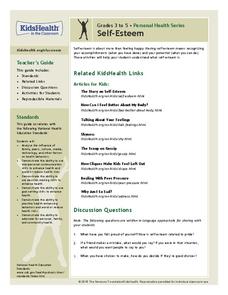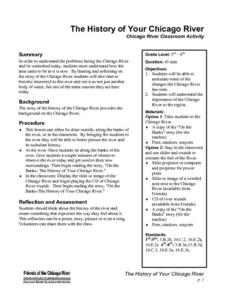Curated OER
Body Image
Students read and answer questions on neural processing and the Pinocchio Illusion. They relate and discuss these topics in conjunction with body-image disorders such as anorexia and bulimia . This lesson include video extension activities.
Curated OER
Music: "Hearing Between The Lines"
The class listens to and reads lyrics from popular songs that explore themes of self-esteem, body image, and eating disorders. The song interpretations will serve as a jumping-off point to deeper discussion on the issues, culminating in...
Curated OER
Developing Cause and Effect Understanding in Severly Multiply Impaired Students
Students are introduced to the concept of cause and effect. Using a switch, they make certain sounds and images appear on their computer. They identify a change in the screen and signal when there is a change in the environment...
Curated OER
Reconstruction
Pupils investigate the historical period of the Reconstruction and the events that surrounded the abolitionist movement. Students use guided questions to conduct research. Then they complete a venn diagram in order to compare two...
Curated OER
Self-Esteem
Students determine what contributes to their self-esteem. In this self-esteem lesson, students participate in a discussion by answering a list of questions. They complete two handouts; one entitled "Who's in the Mirror?" and another...
Curated OER
Pablo Picasso
In this online interactive history instructional activity, students respond to 10 short answer questions about Pablo Picasso. Students may check some of their answers on the interactive instructional activity.
Curated OER
Challenge to Communicate
Students use Lewis and Clark's journals to identify the forms of non-verbal communication they used. They discover the problems they faced on their journey and how they overcame them. They practice using the non-verbal language of the...
Curated OER
Pictographic Poetry of Current Events
Students discuss recent currents events as a class. Using one of the events, they write a poem about how they feel about the event in question. They choose specific symbols that relate to event and write a poem about it as well. They...
Curated OER
Archeological Finds
Young scholars explore archeology and it contributions to human history. They write a magazine article describing the discovery of a dig.
Curated OER
Challenge to Communicate
Pupils examine the journals from Lewis and Clark and identify how they spoke without using words. They participate in a game in which they use non-verbal communication with each other. They write their own journal entries to complete...
Curated OER
Japanese Bookbinding Kit
Students are introduced to Japanese bookbinding techniques. In groups, they compare and contrast the western style against the Japanese style. As a class, they make their own book binding to present the material in a more interesting way.
Curated OER
The History of Your Chicago River
Learners examine the history of the Chicago River. In groups, they identify the problems of the watershed and develop possible solutions. As a class, they examine the importance of the river to the Chicago area by reading a story. To...
Curated OER
Teaching Lewis and Clark: Challenge to Communicate
Students note instances in the journals of Lewis and Clark where they relied on non-verbal communication (sign language.) They discover some basic sign language and play a game in which they must use their new sign language skills to...
Curated OER
Tortured Beauty
Learners compare and contrast two fundamentally different treatments of women, one Chinese and one Japanese, and to examine how this reflects on the culture that produced them.















